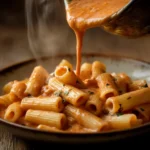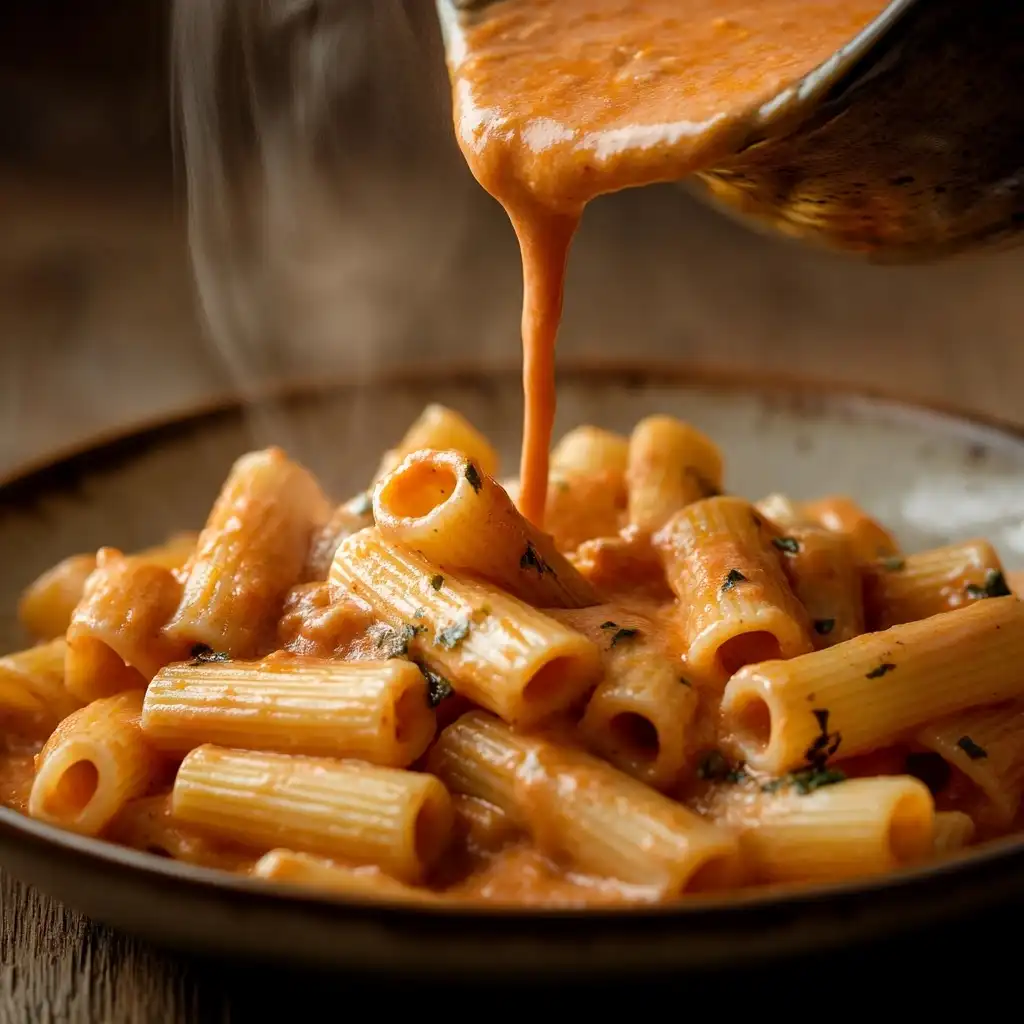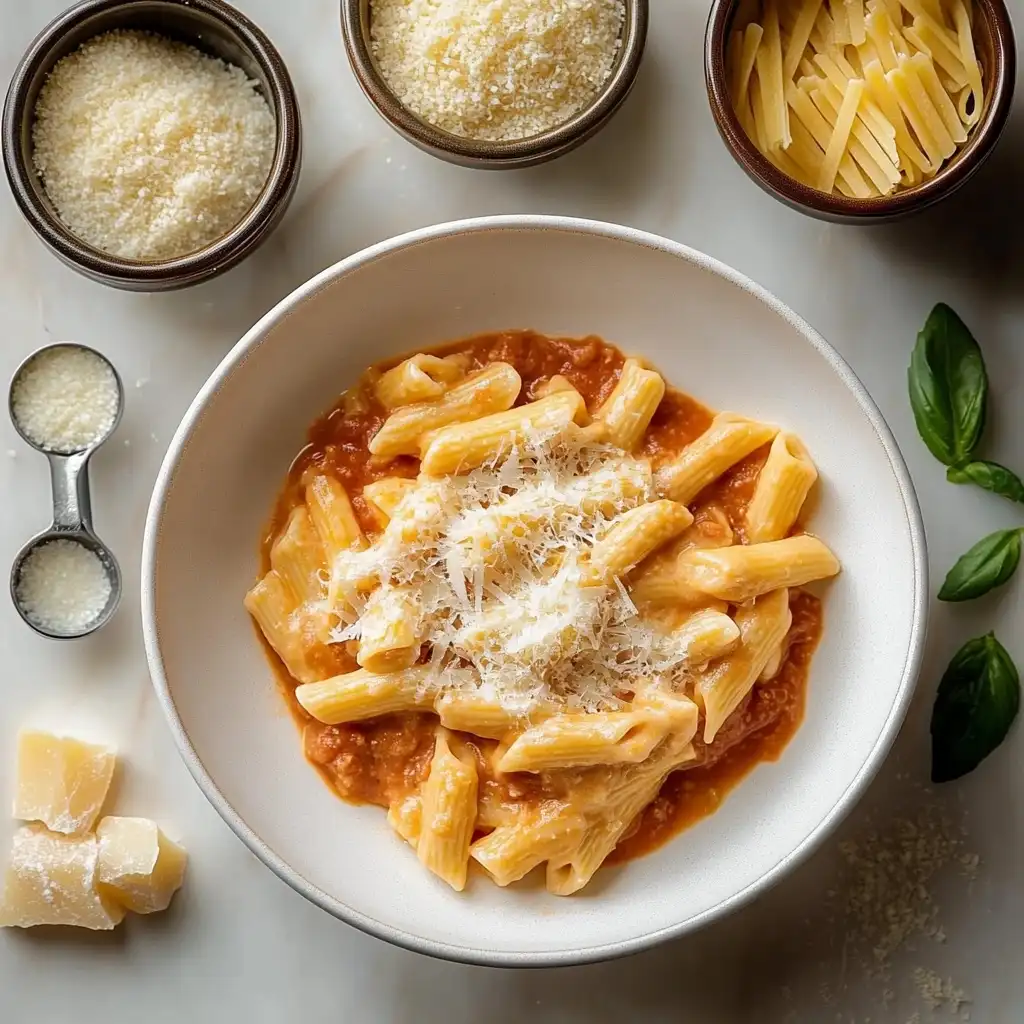How to add cottage cheese to pasta sauce without making it lumpy or bland? It’s easier than you think — and way more delicious. Cottage cheese adds a rich, creamy texture and a serious protein boost to any pasta dish. Whether you blend it into tomato sauce or stir it into a white sauce, cottage cheese transforms your meal without the heavy cream. In this guide, I’ll show you exactly how to add cottage cheese to pasta sauce so it’s smooth, flavorful, and family-approved. Plus, I’ll share tips, variations, and FAQ answers to help you master this simple dinner upgrade.
Print
How to Add Cottage Cheese to Pasta Sauce: Easy Creamy Upgrade for Protein-Packed Flavor
- Total Time: 15 minutes
- Yield: 2 servings 1x
Description
This creamy, high-protein pasta sauce blends cottage cheese with tomato or white sauce for a healthy, satisfying twist on classic comfort food. Perfect for quick weeknight meals or protein-packed meal prep.
Ingredients
1/2 cup cottage cheese (full-fat recommended)
1 cup marinara sauce (or homemade)
1/2 cup reserved hot pasta water
1 tbsp olive oil
2 cloves garlic, minced
1/4 onion, finely chopped
1/4 tsp salt
1/4 tsp black pepper
1/4 tsp chili flakes (optional)
2 tbsp grated parmesan (optional)
Fresh basil for garnish
Instructions
1. In a skillet, heat olive oil over medium heat. Sauté garlic and onion until softened, about 3–4 minutes.
2. Add marinara sauce and simmer for 5 minutes until warm.
3. Reserve 1/2 cup hot pasta water before draining the pasta.
4. In a blender, combine cottage cheese, 1/3 cup sauce, and pasta water. Blend until smooth and creamy.
5. Return blended mixture to skillet with remaining sauce. Stir to combine and gently heat on low (do not boil).
6. Season with salt, pepper, and chili flakes to taste.
7. Serve over hot pasta and garnish with basil and parmesan.
Notes
Use full-fat cottage cheese for best flavor and texture.
To make a white sauce version, swap marinara for broth or unsweetened milk and add extra garlic.
Avoid boiling the sauce after blending to prevent curdling.
Great for meal prep — store in fridge up to 4 days.
- Prep Time: 5 minutes
- Cook Time: 10 minutes
- Category: Dinner
- Method: Stovetop
- Cuisine: Italian-American
Nutrition
- Serving Size: 1.5 cups
- Calories: 310
- Sugar: 6g
- Sodium: 580mg
- Fat: 11g
- Saturated Fat: 4g
- Unsaturated Fat: 5g
- Trans Fat: 0g
- Carbohydrates: 35g
- Fiber: 4g
- Protein: 18g
- Cholesterol: 22mg
Keywords: how to add cottage cheese to pasta sauce, high-protein pasta, healthy pasta sauce
Table of Contents
The Story & Intro

Why I Started Adding Cottage Cheese to Pasta Sauce
If you had told me a few years ago that I’d be teaching people how to add cottage cheese to pasta sauce, I would’ve laughed. But then my priorities shifted — I wanted meals that were comforting, high in protein, and didn’t rely on heavy cream. That’s when I discovered how to add cottage cheese to pasta sauce and change my dinners for good.
One night, tired and hungry, I stared into my fridge and pulled out a tub of cottage cheese. I’d read that you could blend it into sauce for extra creaminess. Curious, I decided to find out how to add cottage cheese to pasta sauce without it tasting weird or turning lumpy.
I scooped the cottage cheese into my blender, added a splash of pasta water and a spoonful of marinara, and hit blend. To my surprise, it turned into the smoothest, creamiest sauce I’d ever made — rich, slightly tangy, and deeply satisfying.
Since that first try, I’ve used this method in dozens of recipes. I now regularly add cottage cheese to pasta sauce for everything from protein-packed penne to lightened-up lasagna. It’s become one of my go-to tricks, alongside egg muffins and overnight oats.
If you’re curious about how to add cottage cheese to pasta sauce for weeknight meals, meal prep, or healthy comfort food, you’re in the right place. And the best part? No one ever guesses it’s cottage cheese.
How Cottage Cheese Became My Weeknight Pasta Hero
When I was commuting and hitting the gym between work and home, pasta was my go-to. But the usual sauces? Not exactly macro-friendly. I needed something that gave me protein, flavor, and comfort — fast. Learning how to add cottage cheese to pasta sauce was the turning point.
At first, I thought cottage cheese would make the sauce grainy. But when I blended it with hot sauce and pasta water, it became smooth, creamy, and rich — like a lighter Alfredo, but way healthier. Once I nailed how to add cottage cheese to pasta sauce the right way, there was no going back.
This trick gave me high-protein dinners without relying on heavy dairy or expensive protein powders. It worked in baked ziti, white sauce, rosé pasta — even in stuffed shells. And yes, I’ve tested it in everything from chickpea pasta to whole wheat rotini.
So if you’ve ever Googled “can you mix cottage cheese with pasta sauce” or wondered how to make pasta sauce healthier, you’re about to find out how to add cottage cheese to pasta sauce in the simplest, tastiest way.
How to Add Cottage Cheese to Pasta Sauce
Blended Cottage Cheese Tomato Sauce Method
Now that you know why it’s worth doing, let’s get into how to add cottage cheese to pasta sauce the right way — for maximum creaminess and flavor. The secret? A blender. Without it, you’ll be left with curds instead of a velvety sauce.
Here’s the exact method I use for a creamy, protein-packed tomato sauce:
- Cook your aromatics. In a skillet, sauté garlic and onion in olive oil until soft.
- Add your marinara. Stir in your favorite jarred or homemade tomato sauce and heat through.
- Reserve pasta water. Scoop out about ½ cup of hot pasta water before draining the noodles.
- Blend cottage cheese. In a blender, combine ½–¾ cup cottage cheese, a ladle of warm sauce, and the pasta water. Blend until completely smooth.
- Return to skillet. Pour the blended mixture back into the pan, stir, and warm gently — don’t boil.
This process shows how to add cottage cheese to pasta sauce so it blends seamlessly, offering the creaminess of an Alfredo with the brightness of tomato.
Tips for Flavor & Texture Success
When learning how to add cottage cheese to pasta sauce, the difference between “eh” and “wow” often comes down to three small details: fat content, temperature, and seasoning.
- Use full-fat cottage cheese whenever possible. It blends smoother, tastes richer, and gives your sauce that luscious mouthfeel.
- Blend warm — not hot — ingredients. If your sauce is too hot when blending, steam buildup can cause a messy explosion. Warm is perfect for emulsification.
- Add pasta water slowly. This not only thins out the sauce, but the starches in the water help bind everything together.
- Balance your flavors. Cottage cheese is naturally tangy, so you may want to add a pinch of sugar if your tomato sauce is acidic or boost umami with a bit of parmesan.

Don’t forget — once you return the sauce to heat, don’t let it boil. Keep it on low just to warm through. Boiling can cause the proteins in the cheese to separate, ruining your smooth finish.
Whether you’re using this trick in a rush or meal-prepping for the week, knowing how to add cottage cheese to pasta sauce gives you a new tool for quick, nourishing dinners.
Creative Variations & Uses
Creamy White Sauce with Cottage Cheese
If you’re wondering can you use cottage cheese in white sauce, the answer is absolutely — and it’s a lighter, healthier twist on traditional Alfredo. You can create a creamy white base without butter or heavy cream using blended cottage cheese, and it’s just as indulgent.
Here’s how to add cottage cheese to pasta sauce when you want a creamy, garlicky white version:
- Sauté minced garlic and onion in a bit of olive oil.
- Add ½ cup broth or unsweetened almond milk for a thinner base.
- Blend with ¾ cup cottage cheese, a splash of lemon juice, salt, pepper, and grated parmesan.
- Warm gently, stirring constantly, until the sauce thickens slightly.
This sauce pairs beautifully with linguine, zucchini noodles, or even gnocchi.
You can also use this style of sauce for:
- White lasagna with chicken and mushrooms
- Mac and cheese base with a protein twist
- Low-fat dipping sauce for veggies or roasted potatoes
Once you understand how to add cottage cheese to pasta sauce for both tomato and cream versions, it opens up tons of new dinner possibilities.
High-Protein Cottage Cheese Pasta Meal Ideas

This method isn’t just a hack — it’s a full-on meal upgrade. Because cottage cheese is naturally high in protein, it transforms your average pasta dish into a post-workout refuel or macro-friendly dinner.
Here are some favorite ways to use it:
- With ground turkey or chicken. Cook meat with spices, then stir in the cottage cheese sauce for a protein-packed meal.
- As a baked pasta base. Try it in baked ziti, penne rosé, or stuffed shells
- For vegetarian power bowls. Toss it with chickpea pasta, spinach, and roasted tomatoes.
One of my readers swapped heavy ricotta with blended cottage cheese in her lasagna and said, “I’ve never felt this good after eating lasagna in my life!”
And if you’re doing meal prep? Cottage cheese sauce stores well in the fridge for up to 4 days. Just reheat it gently and add a splash of water to refresh the texture.
Knowing how to add cottage cheese to pasta sauce gives you so many versatile, healthy meal options — and once you start, you won’t want to go back.
Conclusion
Now that you know exactly how to add cottage cheese to pasta sauce, it’s time to give your weeknight meals a creamy, healthy boost. Whether you prefer tomato-based sauces or want a white sauce alternative, cottage cheese delivers texture, protein, and flavor — all in one quick step. Blend, stir, enjoy. Your pasta just got a whole lot better.
for more recipes follow us in facebook and pinterest
Can you mix cottage cheese with pasta sauce?
Yes, you can absolutely mix cottage cheese with pasta sauce — and it’s a fantastic way to make it creamy and more nutritious. The key is to blend the cottage cheese first to create a smooth texture. Many people ask how to add cottage cheese to pasta sauce without it curdling or becoming gritty. The answer? Blend it with a bit of warm pasta water or sauce before heating, and then stir it into your marinara or cream sauce gently.
Does cottage cheese melt in sauce?
Cottage cheese doesn’t melt in the traditional sense like cheddar or mozzarella. Instead, it softens and blends — especially when processed in a blender. If you’re trying to figure out how to add cottage cheese to pasta sauce for that velvety texture, skip the spoon and use a blender. Blending with sauce and hot water creates an emulsified, creamy base that behaves more like Alfredo than curds.
How do you add cheese to pasta sauce?
When adding cheese to pasta sauce, timing and temperature matter. Always reduce heat before stirring in cheese to avoid clumping or separating. For softer cheeses like cottage cheese, blending before heating is ideal. Knowing how to add cottage cheese to pasta sauce involves a few smart steps: blend it with warm sauce, add seasoning, and avoid boiling after combining. This keeps your sauce smooth, creamy, and cohesive.
Can you use cottage cheese in white sauce?
Definitely! Cottage cheese is an excellent substitute for cream in white sauce recipes. Blend it with a little milk, garlic, and parmesan to create a silky, lower-fat alternative to Alfredo. If you’ve been searching how to add cottage cheese to pasta sauce in a way that fits your nutrition goals, this white sauce version is the answer. It’s protein-rich, comforting, and perfect for baked dishes too.
